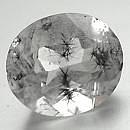|
Click on a letter above to view the list of gems. |
|
|
|
|
|
|
|
|
Hollandite
(inclusions
in Quartz) |
|
| | |
| Discovered in 1906; IMA status: Valid (pre-IMA; Grandfathered) | ||
|
| ||
|
Chemistry |
|
|
| |
|
Ba(Mn4+,Mn2+)8O16 | |
|
|
Barium Manganese Oxide |
|
Molecular Weight: |
852.99 gm |
|
Composition: |
Barium |
12.88 % |
Ba |
14.38 % |
BaO |
|
|
Sodium |
0.27 % |
Na |
0.36 % |
Na2O |
|
|
Manganese |
42.51 % |
Mn |
4.16 % |
MnO / 62.17% MnO3 |
|
|
Aluminum |
0.63 % |
Al |
1.20 % |
Al2O3 |
|
|
Iron |
8.51 % |
Fe |
12.17 % |
Fe2O3 |
|
|
Silicon |
0.33 % |
Sii |
0.70 % |
SiO2 |
|
|
Lead |
4.86 % |
Pb |
5.23 % |
PbO |
|
|
Oxygen |
30.01 % |
O |
|
|
|
|
|
100.00 % |
|
100.38 % |
= TOTAL OXIDE |
|
|
|
||||
|
Classification |
|
|
| |
|
Oxides | |
|
4/D.08-60 | |
|
|
4 : OXIDES (Hydroxides, V[5,6] vanadates, arsenites, antimonites, bismuthites, sulfites, selenites, tellurites, iodates)
|
|
Related to: |
Cryptomelane Group |
|
|
|
|
Crystal Data |
|
|
|
|
|
Crystals short prismatic with flat pyramidal termination, to several em; radial fibrous, massive. |
|
|
Common on {101} |
|
|
|
|
|
Physical Properties |
|
|
|
|
|
Distinct/Good, Prismatic |
|
|
Brittle |
|
|
4.7 - 6.0; VHN = 488-560 || [001], 620-689 - [001] (100 g load) |
|
|
4.95 (g/cm3) |
|
|
None |
|
|
Not Radioactive |
|
|
|
|
|
Optical Properties |
|
|
|
|
|
Black, Grayish Black to Silvery Gray |
|
|
Opaque |
|
|
Metallic, Earthy (Dull) |
|
|
R1-R2: (400) 31.3-37.7, (420) 31.2-37.4, (440) 31.1-37.1, (460) 30.5-36.5, (480) 29.7-35.9, (500) 29.1-35.0, (520) 28.5-34.2, (540) 27.8-33.1, (560) 27.1-32.2, (580) 26.6-31.5, (600) 26.3-30.9, (620) 26.1-30.4, (640) 25.8-30.0, (660) 25.6-29.5, (680) 25.3-29.0, (700) 25.0-28.4; Biaxial |
|
|
0.000 |
|
|
n/a |
|
|
Weak |
|
|
Strong; color in reflected light: White |
|
|
|
|
|
Occurances |
|
|
|
|
|
Geological Setting: |
A primary mineral in contact metamorphic manganese ores, and a secondary weathering product of earlier manganese-bearing minerals. |
|
Common Associations: |
Bixbyite, Braunite, Piemontite, other manganese oxides |
|
Common Impurities: |
Fe, Pb, K, Na |
|
Type Locality: |
Kajlidongri mine, Jhabua District, Madhya Pradesh, India |
|
Year Discovered: |
1906 |
|
View mineral photos: | |
|
|
|
|
More Information |
|
|
|
|
|
| |
|
|
|
|
Hollandite
is found in these locations: in India, at Kajlidongri
and Sitapar, Chhindwara district, Madhya Pradesh; in
the Nagpur and Balaghat districts, Maharashtra; at Banswara,
Rajasthan; and elsewhere. From Sorharras, Ultevis, Sweden.
In Norway, from Tangen, Hurdal. At Langenberg, Saxony,
Germany. From Inken, Tiovine region, Morocco. In the
USA, in the Artillery Mountains, Mohave County, and
in the Apache mine, Sierra Ancha district, Gila County,
Arizona. As fine inclusions in Quartz from Madagascar.
|
|
|
We
have not photographed our Hollandite gems. Please
check back soon. |
